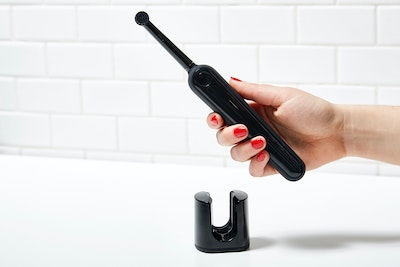How to Know If You Are Overbrushing Your Teeth
Ever since we were little kids, we have been told to brush our teeth morning and night and to sing the happy birthday song twice while doing it. But should we be brushing more than twice a day? Should we just brush for two minutes or should it be five? While most have us have held strong to that childhood routine, maybe others are wondering if that is still the best teeth brushing routine. We all know that it is considered poor health to brush too little but is it also detrimental to brush your teeth too much? Well today, we are going to finally get to the facts of how long you should brush your teeth and the most efficient methods to get the job done right!
So can you brush your teeth too much? The American Dental Association recommends brushing at least twice a day and flossing once a day. The reason why dentists recommend brushing for two minutes is that that is how long it takes for the fluoride in toothpaste. This helps fight cavities by remineralizing enamel and making it more resistant to cavity-causing acids; to take effect. However, brushing your teeth for longer than two minutes does not mean that you will have a more effective clean. It actually can be worse for your teeth!
Let’s take a closer look at the dangers of overbrushing your teeth.
Negative Effects of Overbrushing
 In a study done by the Journal of Dental Research, researchers found that overbrushing can lead to gums receding and sensitive teeth. However, this is not the only negative side effect of overbrushing.
In a study done by the Journal of Dental Research, researchers found that overbrushing can lead to gums receding and sensitive teeth. However, this is not the only negative side effect of overbrushing.
Over time, overbrushing can irritate tooth surfaces which could result in added plaque or calculus resulting in tooth decay.
In addition, brushing too hard can also wear down tooth enamel, which is the thin protective covering of your teeth.
Lastly, overbrushing can cause gum recession which could expose tooth roots and make them more vulnerable to decay.
So not only is overbrushing detrimental to your dental health, it does not offer any added benefits of an extra clean.
Prevent Overbrushing With Effective Brushing
So then you are likely now wondering what method experts recommend for a thorough clean? Dentists recommend a technique called effective brushing. Effective brushing entails a full two minutes of brushing in each section of your mouth with an emphasis on the gum line and two outside sections of your molars.
Also, experts recommend brushing gently with short back and forth strokes at a 45-degree angle to get into those difficult places around your gums. Using a simple timer is helpful when learning how long you should be brushing because it will help ensure that you do not over brush!
Flossing daily also helps remove plaque buildup between the teeth that brushing alone does not remove easily. It is also important that you do not eat or drink within 30 minutes of brushing your teeth or right before bedtime to ensure you get enough saliva in your mouth to re-mineralize the tooth enamel and fight off bacteria overnight.
Which Toothbrush Should You Be Using?
When it comes to the best brush, dentists recommend an ADA approved-toothbrush with soft or extra-soft bristles. Brushes that are more abrasive on teeth and gums can lead to gum recession which is one of the negative side effects mentioned before. Dentists also recommend replacing your toothbrush every three months or when the bristles are starting to look frayed or broken.
Do Electric Toothbrushes Lead to Overbrushing?
 But what about electric toothbrushes? Are they worth the hype and a higher price point? That just depends on your preference and what your dentist recommends.
But what about electric toothbrushes? Are they worth the hype and a higher price point? That just depends on your preference and what your dentist recommends.
However, dentists do advise using gentle back and forth motions and not holding the brush so tightly against your teeth that it makes it difficult to move.
It is worthwhile to note that electric toothbrushes provide a bonus by moving the bristles for you. Also many are designed with smaller bristles and are a better shape to get into the tough areas and unique shapes of your teeth.
The rule remains the same with electric toothbrushes though, you should replace the head every three months. If you don’t like the idea of an electric toothbrush, no problem!
Studies have found that manual brushing can be just as good as electric as long as you are brushing for the recommended two minutes and following the proper methods.
So whether you are using a manual or electric toothbrush, as long as you take your time to ensure that you brush gently along your gumline and teeth with short back and forth motions at a 45-degree angle, then you will be able to achieve the best clean possible!
Don’t forget that as important as a good toothbrush is, it won’t do you any favors if it is not being stored properly! To ensure that germs stay out of your toothbrush, you should keep it covered in either a clean case or in the box that it came in when not being used.
Additionally, be sure to let it air dry after using and store it upright instead of on its side. This allows water to drain out of the bristles more easily which ensures less bacterial growth and buildup on your brush.
Which Toothpaste Should You Be Using?
Since there are seemingly hundreds of toothpaste tubes at the store, what does a good toothpaste look like and which one is the best to use? When deciding what kind of toothpaste to buy, opt for those with fluoride as this ingredient helps strengthen enamel during wear from chewing. Other ingredients to look for in toothpaste include calcium sodium phosphosilicate, triclosan, and a copolymer which all help prevent plaque buildup further.
Avoid toothpaste with artificial flavors and colors as those ingredients could contain harmful chemicals. Also if you suffer from tooth sensitivity, look for a toothpaste that is specifically made for sensitive teeth. Again, consult your dentist if you need help choosing a specific toothpaste for your dental care and needs.
When it comes to applying toothpaste onto your brush, many dentists recommend applying a pea-size amount of paste. If you use too much toothpaste then this defeats the purpose because you will get less fluoride exposure from brushing with too much.
Try not to add too much water to your toothbrush and wait to rinse until you are done. This can also decrease how much fluoride you will get from brushing since some of it gets removed from the bristles with water. With these things in mind, you should be able to choose a toothpaste that is right for you.
Don’t Forget to Floss
The last step of an effective toothbrushing routine is to remember to floss!
Flossing once a day reaches areas that your toothbrush can’t. Dentists recommend using an 18-inch piece of dental floss which should be wrapped around your three middle fingers on one hand. Then pass the other end of the floss in between two teeth and pull it up against the surface of your teeth where it meets with the gumline.
Use a gentle sawing motion to pass the floss back and forth between your teeth while making sure that not only does it pass underneath your gumline but also through each space in between each tooth as well.
If you seem to have trouble flossing regularly, a water flosser may be a good option for you! Water flossers are no longer marketed as “water picks” since they produce a jet of water rather than a single stream to remove food particles and plaque from hard-to-reach places between your teeth.
While studies still need to be done about the long-term effects of water flossers, they can safely and effectively remove plaque in between teeth and ensure that your gums stay healthy when used with an effective brushing routine.
What About Teeth Whitening?
 Teeth whitening treatments and toothpaste are becoming increasingly popular. These products typically contain hydrogen dioxide which is also known as carbamide peroxide, an ingredient typically found in over-the-counter teeth whitening pens and strips.
Teeth whitening treatments and toothpaste are becoming increasingly popular. These products typically contain hydrogen dioxide which is also known as carbamide peroxide, an ingredient typically found in over-the-counter teeth whitening pens and strips.
The concentration of hydrogen dioxide in these products can be up to 10% which is very low but can whiten your teeth over time.
However, if you have sensitive teeth these products may irritate the gums and cause discomfort.
While these teeth whitening products are not necessary to dental health, you may like the cosmetic appearance of whiter teeth so feel free to add it into your tooth brushing routine, but in moderation.
Effective Tooth Brushing Checklist
So the next time you are wondering if your teeth brushing routine is enough or too much, just run through this checklist:
1. Brush twice a day. Preferably after breakfast and before bed.
2. Brush for two minutes in gentle back and forth motions at a 45-degree angle.
3. Use fluoride toothpaste.
4. Use an ADA-approved soft-bristled toothbrush.
5. Floss at least once a day.
6. Visit your dentist every 6 months for regular cleanings and to ensure you have the best routine for your dental health!

